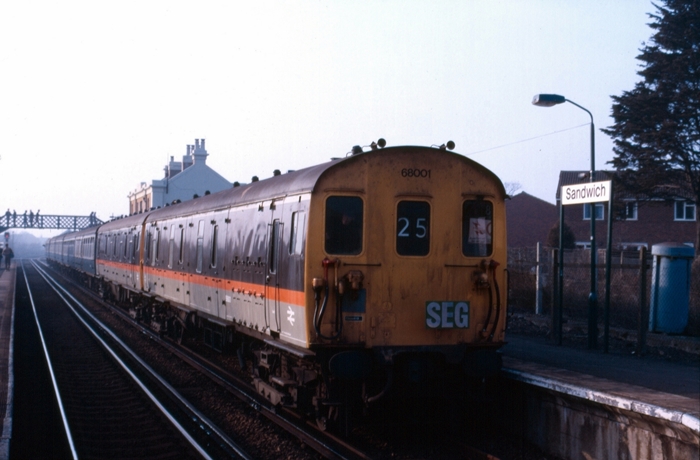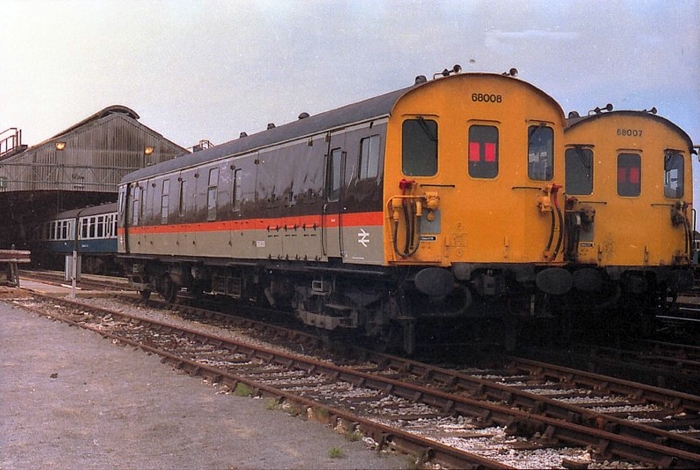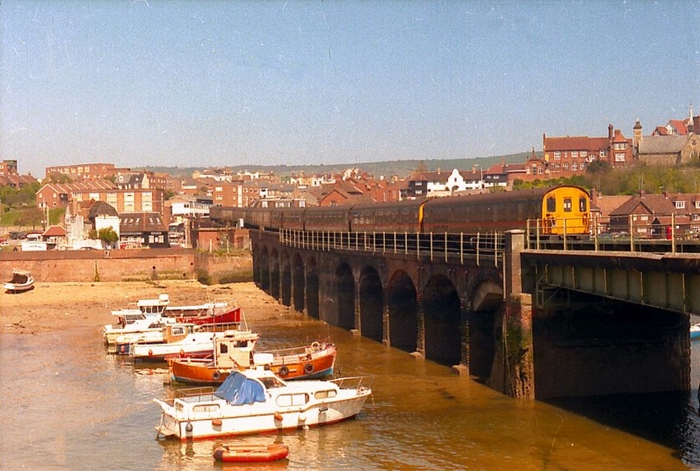
Class 419
MLV: Motor Luggage Van
In 1972, a new computerised numbering system was introduced by British Rail,
whereby locomotives and multiple units were designated by five and six figures
respectively. Under this scheme, known as the ‘’Total Operations Processing
System’’, MLVs were designated ‘’Class 419’’ and, at least on paper, allocated
new numbers. Long after this, however, fleet members still carried their
carriage numbers on the cab fronts (minus ‘’S’’ prefix), even after subsequent
repaints. With reference to the latter, the MLVs have carried an interesting
array of colour schemes, of which the all-over BR(S) Green and Corporate
Blue/Grey have already been mentioned. The former was slightly modified by the
inclusion of small yellow warning panels, a safety feature applied to BR diesel
and electric stock from 1962 onwards. After British Rail Sectorisation (4th
January 1982), an interesting array of liveries were worn by the fleet, these of
which are depicted in many of the below photographs. Nevertheless, brief mention
of these schemes is appropriate. First of note is the ‘’Jaffa Cake’’ scheme,
formally launched as part of the Hastings Line electrification on 12th May 1986.
This livery came to prominence with
the 4-CEP units deployed on Charing Cross to Hastings services, the delightfully
named ‘’1066 Electrics’’ (these were, however, not the first items of rolling
stock to wear the colours). It adorned other electric unit types, including
the MLV fleet: it featured a dark brown upper body side, a light grey lower
body side, frescoed with an orange stripe. The ‘’London & SouthEast’’ Business
Sector was formally re-launched as ‘’Network SouthEast’’ on 10th June 1986, and
the ‘’Jaffa Cake’’ livery gave way to a colourful, but nevertheless pleasing,
blue, red, and white ‘’toothpaste’’ scheme. Several MLVs did not receive this
later livery and in fact ended their days in the earlier L&SE colours. Reduction
in boat traffic during the 1980s saw MLVs employed on a greater range of duties,
notably forming parcels workings. As a result, in October 1988, MLV No. 419004
emerged from Selhurst Depot in bright Royal Mail red, complete with full yellow
ends and TOPS unit number. It was soon joined in this scheme by No. 419001, but
after the former was held up and robbed, the pair were soon repainted into
standard NSE colours.
Interesting workings in years gone by have included those where MLVs have been
used to haul single water tanks. In particular, this occurred during March 1991,
when a water shortage required British Rail to transport water from a well at
Dover, to re-fill carriage washing machines at Ashford and Ramsgate. There have
also been occasions when these interesting units have strayed from South Eastern
Division metals; occasionally they were used to form the Victoria to Bognor
Regis newspaper trains, substituting for the more customary Class 33 and 73
locomotives. MLVs were still recorded on boat trains as late as December 1990
(the author would be interested to know of any later sightings), but withdrawal
of six of the type occurred five months later. By October 1991 all were, at
least on paper, in departmental service. Nos. 931091 and 931094 went to Slade
Green as ‘’depot donkeys’’, both in NSE colours. Nos. 931093 and 931099
(formerly Nos. 419003 and 419009) became depot pilots at Strawberry Hill, where
their third rail and vacuum-braked abilities were beneficial at the site. No.
931093 was repainted into all-over BR Blue for this new role and No. 931099 wore
the popular ‘’Jaffa Cake’’ scheme. It was intended for at least one of the pair
to be equipped with ‘’Sandite’’ and de-icing gear. The remainder were based at
Ramsgate, although some of these were stored out of use. The fleet size was
reduced from ten to nine, when a shunting accident in December 1991 led to No.
931096 sustaining damage beyond economical repair. In 1996 the entire MLV
fleet, bar the scrapped No. 931096, was moved to Bournemouth Depot, where the
vehicles
went into store pending disposal. Privatisation had seen these vehicles pass
into the hands of rolling stock leasing company ‘’Porterbrook’’, and this firm
started the disposal process in February 2000. Apparently, no reasonable offer
would be refused and, thankfully, all examples were eventually acquired for
preservation.
|
Coach Number |
TOPS Number |
Departmental Number* |
|
|
|
|
|
S68001 |
419001 |
931091 |
|
S68002 |
419002 |
931092 |
|
S68003 |
419003 |
931093 |
|
S68004 |
419004 |
931094 |
|
S68005 |
419005 |
931095 |
|
S68006 |
419006 |
931096 |
|
S68007 |
419007 |
931097 |
|
S68008 |
419008 |
931098 |
|
S68009 |
419009 |
931099 |
|
S68010 |
419010 |
931090 |
|
|
|
|
* Only a few members of the class appear to have displayed their allocated departmental number, notably Nos. 419001, 419002, and 419010
15th March 1986

MLV Nos. 68001 and 68005 are seen at Sandwich on the Southern Electric Group's ''Vulcan Van Train'', fronting vacuum-braked locomotive-hauled BR Mk 1 stock. Next stop: Folkestone Harbour. The MLV units had been taken out of service temporarily in the previous year due to braking problems, after an incident on the main line. © David Glasspool Collection
1987

A view at the Margate end of the Ramsgate's carriage cleaning shed shows MLV Nos. 68007 and 68008, the latter displaying the attractive ''Jaffa Cake'' livery of the London & SouthEast sector. Despite the repaint, vehicle numbers were displayed instead of the TOPS number. © John Horton
15th May 1987

A classic boat train scene depicts MLV No. 419008 (now showing TOPS number on the cab front) descending Folkestone Harbour viaduct with a 12-CEP in tow, the entire formation being in ''Jaffa Cake'' livery. © John Horton
Return to the Kent Rail Homepage or alternatively, check for Updates.
Website & Copyright information - Links - Contact the Webmaster
All content is copyright © David Glasspool unless otherwise stated